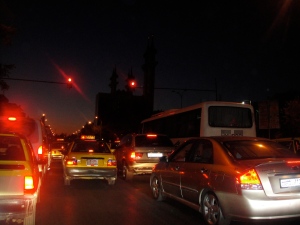
A hot breeze blows through the open windows, a pop song blares through the speakers, and just as you relax, a car swerves in front of you to make a last-minute turn. Wa la yahimak/No worries, your driver says, everything is under control. Everyone knows that Arabs are fantastic drivers –the best– or so they all think. If you are fortunate enough to be in the passenger’s seat with your fellow Arab behind the wheel, say a prayer under your breath, don’t hold on too tightly to your seat (that’s rude), enjoy the view, and keep in mind the following “cultural” curiosities to put you at ease.*
1. After Arabs have lived in America for too long and have gotten used to boring American traditions like staying in lane, using turn signals, and automatically clicking the seat belt, they realize they can no longer drive in the homeland. That’s sad because it can be great fun, if you embrace this simple concept: Arabs drive like they walk, no waiting, no rules, and no logic. Driving in the Middle East is based on a fundamental concept called tahsh, which is a hybrid of both push and shove. It is used to squeeze as many bodies or automobiles into a space as possible. Why? To move faster. Remember, no logic.
2. The soundtrack of the streets in Arabland: a symphony of horns. Honking is an added defense mechanism against: pedestrians jumping in front of cars, trying to cross a 4-lane street against the light; cars that decide to change lanes at the last possible second without using side-view mirrors; parked trucks that suddenly go into reverse without looking in rear-view mirrors. If you are a young woman driving in the Middle East, invest in an extra horn. When needed, flip a switch and your normal horn turns into one that belongs on a semi, really loud and really scary. Use sparingly, in extreme situations to advert an accident with someone who isn’t paying attention or when a taxi is just driving too slow and bugging you.
Social-honking is a charming way to let your friend know that you are outside, ready to pick them up. Everyone has a personal melody, a sound signature, like the favored da da da daaaaa da da. Using three short honks is the most sophisticated. Or just leave them a “missed call”, it’s free and reduces noise pollution.
3. Rear-view and side-view mirrors (or any reflective surface that you can use to your advantage): primarily decorative. See #2.
4. Turn signals: Also decorative. Why use a blinking light when you can just stick your arm out the window to indicate that you intend to turn left? Think of it as an arm-toning exercise. What about turning right, you ask? No problem just ask your passenger to do the same from their side. It gives them something to do. Driving alone? Now you’re just being difficult.
5. Arab driver’s view on lanes: “You mean the arbitrary yellow and white markings that change from dotted to continuous, from double to single, are meant to keep cars between them? Why have only two lanes when we can fit three cars in the same space? And if I stay in my lane, how can I shake my buddy’s hand through the window when we are at the red light?” Psychologically, driving in a lane is like standing in line, a difficult, abstract concept. This is why tahsh is used instead.
5. Seat Belts: Who knew that amazing, brilliant, Lebanese-American, super-hero Ralph Nader (yeah, I like him) would be the guy who gets America to buckle up, while his own country still eschews the life-saving accessory? Arabs hate seat belts so much, they invented elaborate ways of tying the belt around the back of the driver to avoid getting a ticket without wearing it. Some even wear the ever-popular seat belt t-shirt. Seriously? This shirt is supposed to keep you from looking silly while wearing a seat belt? Sorry, Ralph.
6. The roundabout or duwwar: Common in Europe and in Massachusetts (known as rotaries), the roundabout causes Americans to recoil in fear. How do you solve a busy intersection with cars coming from all directions? An American urban planner would just slap a traffic light at each corner and call it a day. Arabs, inspired by the French, use the more elegant solution, the duwwar, a circle that eliminates the need for traffic lights to keep vehicles moving and traffic flowing. The problem? To use the duwwar, you practically have to be French to answer the complex question: who has the right-of-way? (Not really, if you are in the circle, you have the right-of-way, if you are entering the circle, yield to those in the circle. If you live in Massachusetts, please reverse this.) As you can imagine, tahsh and roundabout equals hot mess. The solution? American, of course: slap traffic lights around the duwwar. Idiotic, but much safer.
7. Traffic lights: a problem when the consensus is, green=go very fast, yellow=go very, very fast and red=go with caution (if no police are around).
Non-Arabs may ask at this point if Arabs are in such a hurry, then why are they always late? Don’t know. Just chill out, keep your head turning like a wound-up spring and feel free to sing along:
“Everyone has cars but my grandfather has a donkey…” (If you get this then you are truly too arab.)
* Taxis, buses, Suzukis, Mercedes, cruising, and parking are not covered in this post. To be discussed later. (Any stories are welcome.)
No comments:
Post a Comment